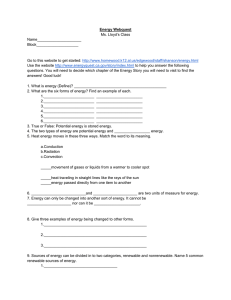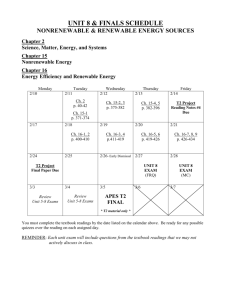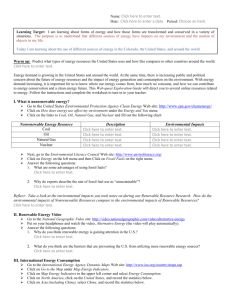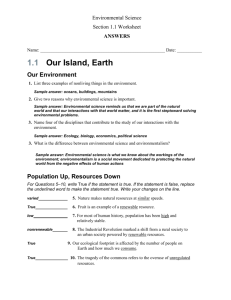Common energy sources
advertisement
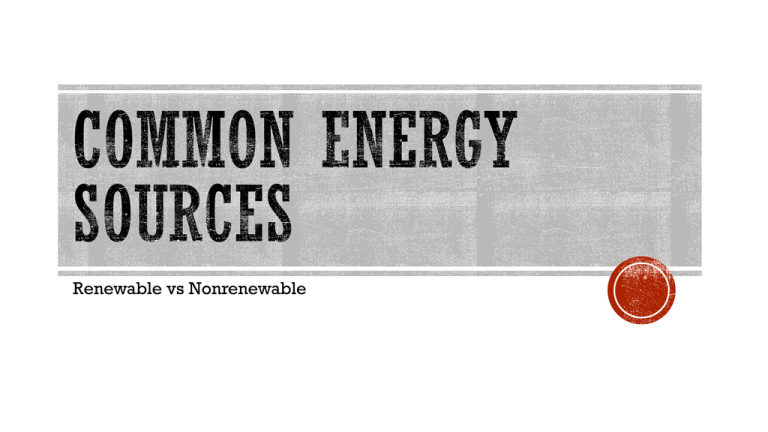
Renewable vs Nonrenewable Renewable Naturally replenished on a human timescale Nonrenewable Also called a finite resource Resource that does not renew itself at a sufficient rate for sustainable economic extraction in meaningful human time-frames vs Nonrenewable Renewable Solar Natural Gas Wind Petroleum or Oil Wood Coal Hydroelectric Nuclear Fission Ocean Tides Geothermal Biomass Renewable Primary source of all energy on Earth Cleanest energy source 0.25% of total U.S. 2012 Energy Consumption Electricity Production Solar cell Concentrated solar Renewable Widely distributed Plentiful Unpredictable 1.43% of total U.S. 2012 Energy Consumption Electricity Production Extracted from air flow using wind turbines or sails Gansu Wind Farm Renewable Major source of carbon dioxide in the atmosphere “Poor man’s oil” Worldwide, provides 50-60% of the people with the barest energy necessities 1.98% of total U.S. 2012 Energy Consumption Heat is used to warm… 1. surrounding areas and/or 2. water Renewable Energy derived from falling water Used since ancient times 2.83% of total U.S. 2012 Energy Consumption Electricity Production Hydroelectric dams Falling water turns giant turbines which drive the generators Three Gorges Dam Renewable Not yet widely used but future potential High costs & limited availability of sites 0.001% of total U.S. 2012 Energy Consumption Electricity Production Tidal steam generators Tidal barrage/lagoon Tidal turbines Renewable Generated from thermal energy generated and stored in the Earth Cost effective & reliable Limited to areas near tectonic plate boundaries U.S. is the largest producer of geothermal electricity 0.24% of total U.S. 2012 Energy Consumption Electricity Production Heat deep underground is used to warm water that turns into steam and turns turbines Renewable This is garbage! As bacteria decomposes organic waste such as manure, food scraps, and pond sludge, methane is produced Some cities produce electricity by burning garbage in especially designed power plants Can be converted into biofuels – methane, ethanol, biodiesel 4.45% of total U.S. 2012 Energy Consumption Nonrenewable Fossil fuel formed when layers of buried organic matter are exposed to intense heat and pressure over thousands of years Hydrocarbon gas mixture consisting primarily of methane Found deep underground in rock formations Must be processed before use 27.34% of total U.S. 2012 Energy Consumption Primarily used to heat homes Nonrenewable Fossil fuel Black, thick liquid pumped up from below Earth’s surface Formed when large quantities of dead organisms, usually algae, are buried subjected to intense heat and pressure Refining process separates the gasoline portion used in transportation Products from the remaining portions include: synthetic rubber, detergents, fertilizers, and textiles 36.48% of total U.S. 2012 Energy Consumption Nonrenewable Most abundant fossil fuel Combustible, black sedimentary rock Primarily carbon Burned for the production of electricity and/or heat Burning coal produces sulfur dioxide (SO2) – results in acid rain Mined either underground or by strip mining 18.27% of total U.S. 2012 Energy Consumption Nonrenewable Discovered in the 1930’s Splitting the nucleus of an uranium atom releases a tremendous amount of heat Power companies use the heat to produce electricity Creates radioactive waste 8.46% of total U.S. 2012 Energy Consumption • Renewable • Naturally replenished on a human timescale • Nonrenewable • Resource that does not renew itself at a sufficient rate for sustainable economic extraction in meaningful human timeframes
